#wp-cli-series
Explore tagged Tumblr posts
Text
How to use WP_CLI::confirm() in WP CLI
How to use WP_CLI::confirm() in WP CLI

In this article let’s learn about WP_CLI::confirm() function.
Note: If you read some recent articles then you can skip some below steps that are related to plugin creation.
Create Empty Plugin
Create a new folder wordpress-examples into plugins directory /wp-content/plugins/
Create a file wordpress-examples.php and add the below code into it.
<?php /** Plugin Name: WordPress Examples */
View On WordPress
0 notes
Text
WP CLI. La linea di comando di Wordpress (Parte 2). Installazione di Wordpress

Siamo giunti alla seconda parte della serie dedicata a wp cli, l’ interfaccia a riga di comando di Wordpress. Nel precedente articolo abbiamo visto come installare wp cli e i comandi da eseguire per scaricare Wordpress.
Se non l' hai già fatto ti consiglio di consultare la prima parte di questa guida.
In ogni caso ti riassumo il comando per scaricare Wordpress:
CODE:
wp core download --locale=it_it
Il download sarà terminato con la visualizzazione del messaggio
CODE:
Success: WordPress downloaded.
Prima di proseguire con l’ installazione voglio aprire una breve parentesi su una opzione che ti sarà molto utile nell' uso di wp cli.
L’ opzione help di wp cli
L’ opzione di wp, come in ogni altro programma a riga di comando, che non dovrai mai dimenticare, è help. Ci tengo a ricordarlo perché spesso ce ne dimentichiamo o preferiamo usare la ricerca di google piuttosto che questa utile opzione che permetterà di farci capire, rapidamente e con facilità, l’ uso di un determinato comando/opzione. Oltre a questo il suo uso è di una semplicità disarmante, quindi non trovo alcuna ragione per escluderlo dalla nostra vita...
Ecco l'output generato

Come puoi notare l' output è suddiviso in varie sezioni:
NAMEDESCRIPTION
SYNOPSIS
SUBCOMMANDS
Oltre a NAME e DESCRIPTION, che non hanno certo bisogno di ulteriori chiarimenti, ono presenti altre due che ci torneranno molto utili nella ricerca :
SYNOPSIS, ci mostra come va utilizzato lo script/comando
SUBCOMMANDS, la lista delle opzioni
Un breve esempio chiarirà meglio il funzionamento
Vuoi scaricare wordpress, non devi fare altro che
digitare il nome dello script, wpcercare in subcommands l' opzione per la gestione di wordpress, core
l' opzione core serve sia per il download che per l' installazione e l' aggiornamento del sistema. Quindi cerca l' opzione corretta con
CODE:
wp help core

Dalla risposta otteniamo le opzioni di core. Per scaricare Wordpress è subito chiaro il comando... download.
Esploriamo l' opzione
CODE:
wp help core download

Dalla sezione SYNOPSIS si evince che puoi usare il comando già cosi costruito, ma usando download da solo scaricheresti Wordpress nella lingua di default. Aggiungendo invece, come nell' esempio mostrato in output, l' opzione --locale=it_IT avrai il cms nella tua lingua preferita. Quindi al termine hai ottenuto il comando cosi formato
CODE:
wp core download
per la lingua di default (inglese)
CODE:
wp core download --locale=it_IT
per la lingua italiana.
Installazione
Scaricato Wordpress sei arrivato al tanto atteso momento di procedere con la sua installazione, ma se inserisci il comando(wp core install) ti verrà mostrato un messaggio di errore per la mancanza di wp-config. Puoi crearlo manualmente, rinominare wp-config-sample.php o usare lo stesso wp per generarlo. Oltre a questo ti occorre anche un database da collegare alla tua nuova installazione, lo farai dopo senza l' ausilio di software esterni. Per ora inserisci il nome del tuo futuro database, user e password come valori nelle opzioni del prossimo comando.
Il comando per creare wp-config
CODE:
wp config create
i suoi parametri
CODE:
--dbname="nome del database"
--dbuser="nome utente del database"
--dbpass="password utente"
Il comando completo:
CODE:
wp config create --dbname=db_name --dbuser=db_user --dbpass=db_password
Generato il file wp-config.php avrai bisogno di creare il tuo nuovo database, indicato in "config create", da associare all' installazione wordpress. Puoi ricorrere a un software esterno specifico come phpMyAdmin o usare wp cli. Ti suggerisco di scegliere il nostro wp. Perché usare un software esterno quando basta una sola riga di codice per svolgere la stessa operazione? Non ti resta che aggiungere l' opzione db create a wp e lo script, attraverso le informazioni contenute in wp-config, provvederà a creare per te il nuovo database.
il nostro database è subito pronto e non ti resta che lanciare il comando finale per l' installazione
CODE:
wp core install
aspetta, valorizza prima i suoi parametri altrimenti riceverai un messaggio di errore
CODE:
--url="url del nuova installazione"
--title="titolo del sito"--admin_user="nome utente"
--admin_email="email utente"
--admin_password="password" (opzionale)
se ometti il campo --admin_password verrà generata una password casuale che utilizzerai per l' accesso. Il comando per l' installazione sarà cosi composto:
CODE:
wp core install --url="localhost" --title="titolo" --admin_user="admin" --admin_email="admin@localhost"
CODE:
L' operazione sarà conclusa con la visualizzazione del messaggio
CODE:
Admin password: qi%RNyO)ziBo5uz1KY Success: WordPress installed successfully.
Ora puoi puntare il browser all' url che hai indicato per la tua installazione, inserisci lo user scelto e la password generata da wp per accedere alla dashboard di wordpress.
Risorse consigliate
Alcune risorse che potresti trovare utili per approfondire l' argomento
Pagina del progetto wp-cli
Manuale ufficiale - wordpress
Elenco completo dei comandi - wordpress
Conclusione
Con questa breve guida ti ho mostrato come, con pochi comandi, puoi avere una nuova installazione di wordpress pronta all' uso. Nel prossimo appuntamento vedrai come sia utile usare wp cli per la gestione degli aggiornamenti del core e dei plugins con la loro attivazione/disattivazione. Nel frattempo, la cosa più importante e che esplori le opzioni di wp cli con help per scoprire quello che potresti farci oltre a quanto discusso. Quindi se hai dubbi o domande non esitare a contattarmi, sarò lieto di rispondere alle tue richieste.
Read article on WordPress
#terminale#wordpress#wpcli#gutenberg#developers#web development#web developers#blogger#blog#ask blog
1 note
·
View note
Text
Learning WordPress Development
WordPress has been coming out with some really amazing upgrades and it just keeps getting better. With Gutenberg happening, it is a good plan to learn some WordPress as it is likely will become even more used.
I collected a series of of tutorial links that I thought were useful below.
OsTraining has nice resources on all kinds of things. There are also many great WordPress tutorials.
In All the WordPress Classes for OSTraining there is the range of “How and Where to Install WordPress“ to “How to Develop WordPress Plugins“ and greats stuff in between.
Of course at Developer.WordPress.org there are pages for WP-CLI Commands, Code Reference, the Theme Handbook, and the Plugin Handbook, all great references.
Also there is https://learn.wordpress.com/ a nice resource that it would be nice if more open source software could provide these kinds of learning resources.
The WordPress Codex, wiki style information is here, and then Pippin’sPlugins has all kinds of blog posts on projects.
1 note
·
View note
Text
Create a Gutenberg Block
In this article you are going to see how to create Gutenberg block.
You are going to learn:
Overview
Requirements
Available Tools
Create Gutenberg Block with create-guten-block
Create Gutenberg Block with @wordpress/block
Create Gutenberg Block with wp scaffold block
Conclusion
Overview #Overview
This article is one of the parts of the series Gutenberg Development: Beginner to Advanced. I am explaining all the details for considering the article for beginner developers. After reading this article you can easily understand the process of creating a Gutenberg block.
In this article we just setup the boilerplate of our first Gutenberg block. So, Let’s see how to create custom Gutenberg block.
Requirements #Requirements
To get started we need a NPM and Node.js to be installed on the system. NPM is a package manager for Node.js. So, After installing the Node.js you’ll get access to use the NPM too.
See the article install the NPM and Node.js
Available Tools #Available Tools
We can create a Gutenberg block from scratch. We custom configure the webpack, Babel, etc but to make the development as simple as possible I’m going to use below tools to create a first Gutenberg block.
We have 3 tools which provides the Gutenberg block development environment. These tools are:
create-guten-block – NPM unofficial but pretty awesome package created by Ahmad Awais.
@wordpress/block – NPM official WordPress package to create a Gutenberg block.
wp scaffold block – WP CLI package to create a Gutenberg block.
All these tools are nice to create a Gutenberg block boilerplate. But, I recommend using the create-guten-block for development. We have a WordPress official tool @wordpress/block for development. The official package @wordpress/block is available from Jan 24, 2020.
I am going to see How to create a Gutenberg block with all the above available tools. Finally, you can choose your favorite tool for creating a Gutenberg block.
Create Gutenberg Block with create-guten-block #Create Gutenberg Block with create-guten-block
The create-guten-block is an awesome tool for developing Gutenberg blocks. create-guten-block is developed by ahmadawais.
create-guten-block provides the ZERO configuration setup. create-guten-block is the same as the create-react-app which is used for creating React applications.
Let’s get started.
Open the Terminal or CMD (command prompt)
Navigate to the \wp-content\plugins\ directory.
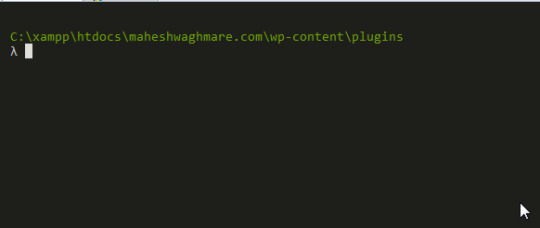
Terminal Window
Type npx create-guten-block {your-gutenberg-block-plugin} command. Note: Above command create a WordPress plugin with your provided plugin name.
I’m using below command:
npx create-guten-block awesome-headings
Here, I am creating a Gutenberg Block plugin with name awesome-headings.
After executing the above command you can see something similar:
λ npx create-guten-block awesome-headings � Creating a WP Gutenberg Block plugin called: awesome-headings In the directory: C:\xampp\htdocs\maheshwaghmare.com\wp-content\plugins\awesome-headings This might take a couple of minutes. √ 1. Creating the plugin directory called → awesome-headings √ 2. Installing npm packages... √ 3. Creating plugin files... ✅ All done! Go build some Gutenberg blocks. CGB (create-guten-block) has created a WordPress plugin called awesome-headings that you can use with zero configurations #0CJS to build Gutenberg blocks with ESNext (i.e. ES6/7/8), React.js, JSX, Webpack, ESLint, etc. Created awesome-headings plugin at: C:\xampp\htdocs\maheshwaghmare.com\wp-content\plugins\awesome-headings Inside that directory, you can run several commands: � Type npm start Use to compile and run the block in development mode. Watches for any changes and reports back any errors in your code. � Type npm run build Use to build production code for your block inside dist folder. Runs once and reports back the gzip file sizes of the produced code. � Type npm run eject Removes this tool and copies build dependencies, configuration files and scripts into the plugin folder. ⚠️ It's a one way street. If you do this, you can’t go back! ✊ Support create-guten-block → Love create-guten-block? You can now support this free and open source project. Supporting CGB means more updates and better maintenance: Support for one hour or more → https://AhmdA.ws/CGB99 More ways to support → https://AhmdA.ws/CGBSupport Check out my best work. VSCode Power User → https://VSCode.pro Get Started → We suggest that you begin by typing: cd awesome-headings npm start
See below screenshot for reference:
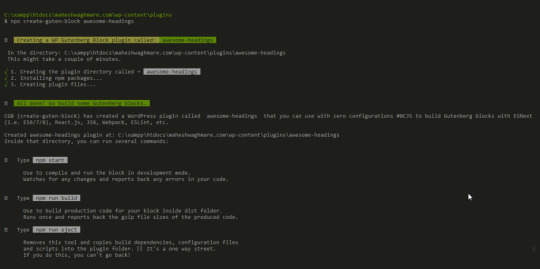
Successfully Created a Gutenberg Block Plugin
If we see the plugins directory the we can see that the new directory awesome-headings with all required files and folders.
See below screenshot for reference.
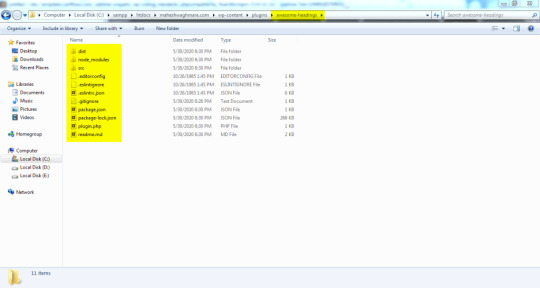
Directory Structure after creating a Gutenberg Block
We have a proper setup for our new block awesome-headings – CGB Block.
We can see the development files and folders into the directory \plugins\awesome-headings\src\
└───block └───block.js └───editor.scss └───style.scss └───blocks.js └───common.scss └───init.php
If you open the file block/block.js then you can see the code something like below:
// Import CSS. import './editor.scss'; import './style.scss'; const { __ } = wp.i18n; // Import __() from wp.i18n const { registerBlockType } = wp.blocks; // Import registerBlockType() from wp.blocks
The above code is written NEW JavaScript format which is ECMAScript 6 is also known as ES6 and ECMAScript 2015 and with JSX.
The new ES6 format is not supported for all browsers also browsers don’t read the JSX expressions. We need to make the browser supported format JS files.
As I describe to you earlier that the create-guten-block tool provides the ZERO configuration setup. So, We don’t need to configure anything.
Simply execute the command npm run build.
What does the npm run build command?
Simply it build the executable files which files browsers can read.
We have a directory \src\ in which we have a .js files (written in ES6 & JSX code) & .scss files. Both files are not readable by browser.
So, The npm run build command create a directory \dist\ and create the .js and .css iles:
└───blocks.build.js └───blocks.editor.build.css └───blocks.style.build.css
Here, We have 3 files which are readable by browser.
Now, Lets create the build files for our awesome-headings – CGB Block Gutenberg block.
Go to \wp-content\plugins\awesome-headings\
Execute the command npm run build e.g.
λ npm run build > [email protected] build C:\xampp\htdocs\maheshwaghmare.com\wp-content\plugins\awesome-headings > cgb-scripts build Let's build and compile the files... ✅ Built successfully! File sizes after gzip: 671 B — ./dist/ blocks.build.js 134 B — ./dist/ blocks.editor.build.css 135 B — ./dist/ blocks.style.build.css � Support Awais via VSCode Power User at https://VSCode.pro →
You can see the screenshot somethine like below:
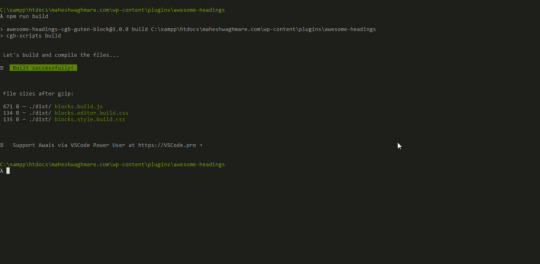
Build the Gutenberg block assets
Now, Our block files are build and ready to see in Gutenberg editor.
Let’s see how our first block looks like in the Gutenberg editor. First we need to activate our plugin.
Go to /wp-admin/plugins.php screen and activate the awesome-headings — CGB Gutenberg Block Plugin.
See below screenshot for reference:
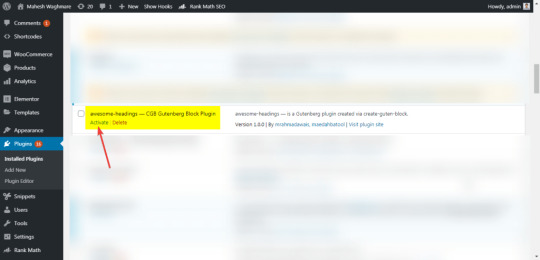
Activate “Gutenberg Block” Plugin
Now, Let’s create a new post from Posts > Add new
Type /awesome in the editor which shows the available bocks.

Inline Gutenberg Block Search
Or
We can search the block in top right corner.
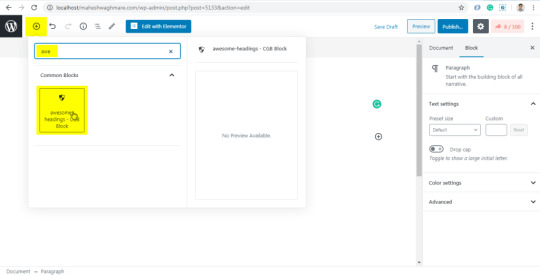
Now, Click on awesome-headings – CGB Block
Click on the Publish button

Publish New Post
Now, Click on View Post to see your post on frontend.
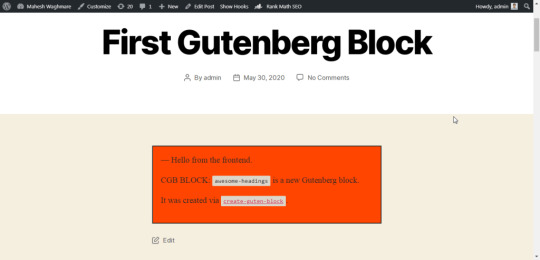
Post Front-End
Here, We can see our first Gutenberg block output in post content.
I have use the default WordPress theme Twenty Twenty to avoid any CSS or JS conflicts. You can use any your favorite theme for development.
I recommend to use the default WordPress themes while development. Also, deactivate all other plugins. Once your development is complete and plugins is ready to test then you can test the plugin with different themes and different plugins.
Create Gutenberg Block with @wordpress/block #Create Gutenberg Block with @wordpress/block
The @wordpress/block is also inspired by create-react-app. The create-react-app is used for creating the react app.
Lets see how to create custom gutenberg block with @wordpress/block.
Goto /wp-content/plugins/ directory and execute below command:
npm init @wordpress/block awesome-heading-with-wordpress-block
Here, the awesome-heading-with-wordpress-block is our plugin name. The package @wordpress/block create a ready to use Gutenberg block for us.
After executing above command you can see something similar:
λ npm init @wordpress/block awesome-heading-with-wordpress-block npx: installed 205 in 62.679s Creating a new WordPress block in "awesome-heading-with-wordpress-block" folder. Creating a "package.json" file. Installing packages. It might take a couple of minutes. Formatting JavaScript files. Compiling block. Done: block "Awesome Heading With WordPress Block" bootstrapped in the "awesome-heading-with-wordpress-block" folder. Inside that directory, you can run several commands: $ npm start Starts the build for development. $ npm run build Builds the code for production. $ npm run format:js Formats JavaScript files. $ npm run lint:css Lints CSS files. $ npm run lint:js Lints JavaScript files. $ npm run packages-update Updates WordPress packages to the latest version. You can start by typing: $ cd awesome-heading-with-wordpress-block $ npm start Code is Poetry
See below screenshot for reference:
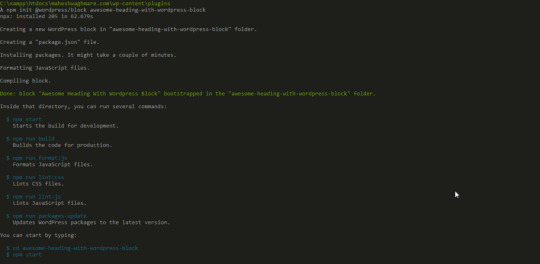
Create new Gutenberg Block with @wordpress/block
Same as create-guten-block the NPM package @wordpress/block also create a directory awesome-heading-with-wordpress-block into /wp-content/plugins/ directory. The file structure looks like below:
└───.editorconfig └───.gitignore └───awesome-heading-with-wordpress-block.php └───build └──────index.asset.php └──────index.js └───editor.css └───node_modules └───package-lock.json └───package.json └───readme.txt └───src └──────edit.js └──────index.js └──────save.js └───style.css
Now, Lets see how our first block looks like in the Gutenberg editor.
Note: Here we have not executed the npm run build command. By default the @wordpresss/block generate the /dist/ directory. If the block is not available from the Gutenberg editor then you can execute the above command.
Create a new post from Posts > Add new
Search from the Awesome Heading With WordPress Block block.
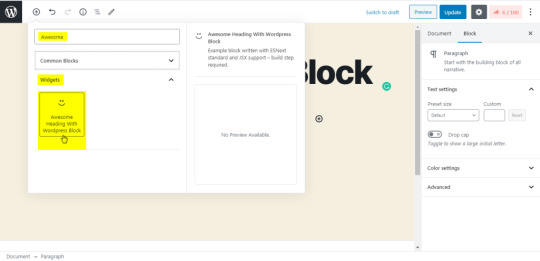
OR
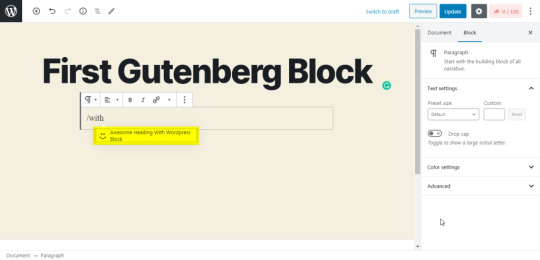
Click on the “Awesome Heading With WordPress Block” which add our block into the editor.
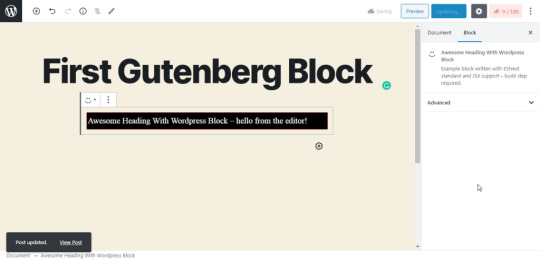
Now, Click on View Post to see the front end.
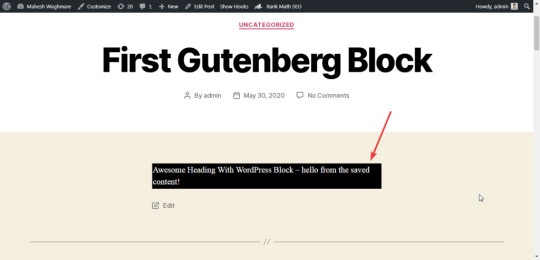
Create Gutenberg Block with wp scaffold block #Create Gutenberg Block with wp scaffold block
Creating the block with wp scaffold block is two step process if we don’t have any plugin.
We are creating a new plugin and a new block wihtin it.
Let’s see how to do it.
Create a new plugin my-gutenberg-plugin with wp scaffold plugin command.
E.g.
wp scaffold plugin my-gutenberg-plugin
After executing above command you can see something below:
λ wp scaffold plugin my-gutenberg-plugin Success: Created plugin files. Success: Created test files.
Here, The new plugin is created into the /wp-content/plugins/ direcotry with my-gutenberg-plugin
Now, Goto our new plugin directory /wp-content/plugins/my-gutenberg-plugin/ and execute below command:
wp scaffold block my-first-block --title="My First Block" --plugin=my-gutenberg-plugin
You can see something like below:
λ wp scaffold block my-first-block --title="My First Block" --plugin=my-gutenberg-plugin Success: Created block 'My First Block'.
Here, We have created a new block My First Block.
Now, Activate the plugin and Lets see how to use it in Gutenberg Editor.
After activate you’ll not see the Gutenberg block. We need to add a single line of code which actually include the block file path.
Add below code into the My Gutenberg Plugin plugin’s my-gutenberg-plugin.php file.
// Your code starts here. require_once plugin_dir_path( __FILE__ ) ) . 'blocks/my-first-block.php';
See below screenshot for reference:
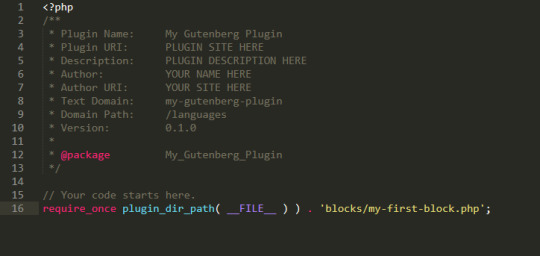
Now, Lets create a post and add our new block My First Block.
NOTE: Here we don’t need to build the JS or CSS files because of the Gutenberg block is created with the regular javascript functions. There is NO any JSX syntax. So, We dont need to build the dist directory. We can directly use our block.
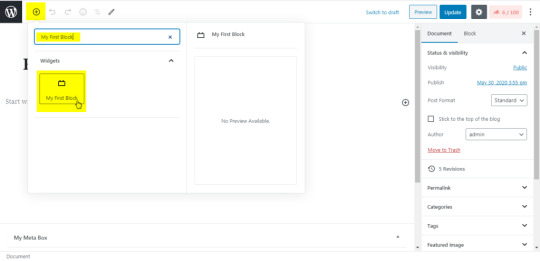



Conclusion #Conclusion
In this article we learn how to create Gutenberg block boilerplate with create-guten-block, @wordpress/block, and wp scaffold block. You can setup your custom development environment or use any of the above tools.
In next article you’ll see How to develop a Gutenberg block in details?
from WordPress https://bit.ly/2ZZYZP4 via IFTTT
0 notes
Text
DOWNLOAD DM20C RO DRIVER
Downloads: 4906 File Format: exe Download Type: http Date Added: 08 October, 2019 File Version: 819131254 Operating Systems: Windows NT/2000/XP/2003/2003/7/8/10 MacOS 10/X File Name: dm20c ro driver Price: Free File Size: 23 Mb Uploader: Plum

Fixed Issues: - Fixed(dm20c ro driver Fixed) some DDR SPD in channel B detected error. - Fixed the error that even if it was user defined for "M" button to stop or playback, playback was not working as it supposed to. - Fixed(dm20c ro driver Fixed) the problem that WRV200 may block the FTP traffic after a random period of time. - Fixed color bit depth issue with DVS 605: When a connected DVS 605 would change from an 8-bit to a 10-bit color bit depth, the FOXBOX HDMI locked up. - Fixed self-healing web display(dm20c ro driver display) issue. - Fixed shutter settings issue for support anti-flicker series. - Fixed samba/ftp cannot modify account issue. - Bug Fixes • HWZ-enabled <video> elements(dm20c ro driver elements) now support scale() and translate() CSS animations. - Fixed a bug where the performance of TeraStation became slow when too many files were copied to the replication target. - Fixed errors of time change(dm20c ro driver change) from Setting>Time menu (For some recently released products). Users content: Now Wireless Channel changed from Auto to default 8. Latest BIOS for 1848-ALP/1848-GLP/1848-OLP. #Enhances Power Management# Supports Wake_On_LAN# Supports Wake_On_Ring# Supports Wake_On_RTCtimer# Supports Suspend-to-Disk. Unable to create Eyefinity configurations through the Eyefinity Advanced Setup option. CLI command to show port link speed is displaying port speed value even WAN link is down. - When the host name or the domain name is modified, the web GUI displays an error. In rare case users are unable to answer calls because the phone of the first user doesn't respond. Remove the Bonjour settings from the Network Setup web-UI Wait 2 minutes for the DSL and Internet lights on the modem to turn green before trying to access the internet. Release notes:- Updated disable WPS-PIN Method. Click here to download DOWNLOAD BROADCOM CORP.BCM5880 SECURE APPLICATIONS PROCESSOR 5880 DRIVER. Supported OS: Windows Server 2008 R2 Windows 8.1/8/7/Vista 64-bit Windows Server 2012 Windows 8.1/8/7/Vista 32-bit Microsoft Windows 8.1 Enterprise (64-bit) Windows 7 32-bit Windows XP 64-bit Windows 8.1 Microsoft Windows 8.1 (64-bit) Windows Server 2008 Windows Vista 32-bit Windows 7 Windows Server 2016 Microsoft Windows 8 Pro (32-bit) Notebook 8.1/8/7 32-bit Windows Vista 64-bit Microsoft Windows 8.1 Pro (64-bit) Microsoft Windows 10 (64-bit) Windows 7 64-bit Microsoft Windows 10 (32-bit) Windows Server 2003 32-bit Windows Server 2003 64-bit Microsoft Windows 8 Enterprise (32-bit) Microsoft Windows 8 (64-bit) Microsoft Windows 8.1 Enterprise (32-bit) Windows Server 2012 R2 Microsoft Windows 8.1 Pro (32-bit) Windows 10 Microsoft Windows 8 Enterprise (64-bit) Windows XP 32-bit Microsoft Windows 8.1 (32-bit) Windows 8 Microsoft Windows 8 (32-bit) Notebook 8.1/8/7 64-bit Windows 2000 Microsoft Windows 8 Pro (64-bit) Searches: dm20c ro driver for Microsoft Windows 8.1 (64-bit); dm20c ro J94f; dm20c ro J JQ941-9; dm20c ro JQVHC9415; dm20c ro driver for Windows Server 2012 R2; dm20c driver ro; dm20c ro Jfr941-frx; dm20c ro driver for Microsoft Windows 8 (32-bit); dm20c ro JQ9415; dm20c ro driver for Notebook 8.1/8/7 32-bit; dm20c ro driver for Microsoft Windows 10 (32-bit) Compatible Devices: Ipad; Wifi router; Hard Drive; Hardware; Memory Card; Usb Cables To ensure the integrity of your download, please verify the checksum value. MD5: aa5195ec5d2d1e6799c30c9ad3a0fca6 SHA1: ea77a18b2c0704a52e5376241eb17f794808f54d SHA-256: 5bc9104d39292a0a2e83c36158a08a34dc2e5dda3c9d6f8ea8986ac05546dc9c
0 notes
Text
Come installare WP-CLI su Windows - Wordpress Command-Line Interface

WP-CLI è lo strumento da riga di comando ufficiale per interagire e gestire il proprio sito WordPress. Può essere utilizzato per una serie di motivi diversi, dall'installazione / aggiornamento del core di WordPress, alla gestione di plugin e temi e così via. In questo breve tutorial spiegheremo come installare WP-CLI su Windows utilizzando i due metodi più comuni: composer o una combinazione di file phar + bat.
Installazione con Composer
Per installare WP-CLI con Composer è consigliabile seguire i passaggi descritti in questa guida ufficiale a cura del sito make.wordpress.org.
Installazione con file PHAR+BAT
Per installare WP-CLI utilizzando un file batch, eseguire le operazioni descritte di seguito: Assicuratevi di avere installato PHP sul vostro sistema e di aver inserito la cartella di installazione nella variabile di ambiente PATH, così da poter eseguire la php-cli a livello globale. Scaricate il file wp-cli.phar da questo indirizzo e salvatelo all'interno di una cartella, ad esempio c:\wp-cli Create un nuovo file con nome wp.bat all'interno della cartella c:\wp-cli appena creata, con il seguente contenuto: @ECHO OFF php "c:/wp-cli/wp-cli.phar" %* L'ultima cosa da fare è aggiungere la cartella c:\wp-cli alla variabile di ambiente PATH. E' possibile farlo sia tramite il Pannello di Controllo di Windows (Sistema > Avanzate) o eseguendo il seguente comando da command-line: setx path "%path%;c:\wp-cli" Una volta fatto questo, sarà possibile utilizzare WP-CLI da qualsiasi finestra Prompt dei Comandi di Windows. Read the full article
0 notes
Text
Jayso - 0106 (Vol. 5) (Full Album)
Jayso – 0106 (Vol. 5) (Full Album)
Jayso – 0106 (Vol. 5) (Full Album). Ghanaian rapper Jayso brings to us a new edition of his 0106 Album.
This happens to be his 6th Edition of his 0106 Series. A collection of heavy bangers recorded during the lockdown in U.K & Ghana due to the Covid-19 pandemic. Features some of the finest young talent in Ghana on this project.
Listen, Enjoy & Share.
Jayso (Skillions Records) · 0106, Vol. 5 Cli…
View On WordPress
0 notes
Text
Apache Kafka Series – Learn Apache Kafka for Beginners v2
START HERE: Learn Apache Kafka 2.0 Ecosystem, Core Concepts, Real World Java Producers/Consumers & Big Data Architecture
What you’ll learn
Understand Apache Kafka Ecosystem, Architecture, Core Concepts and Operations
Master Concepts such as Topics, Partitions, Brokers, Producers, Consumers
Start a personal Kafka development environment
Learn major CLIs: kafka-topics, kafka-console-producer,…
View On WordPress
#Apache Kafka 2.0 Ecosystem#Apache Kafka Series#Big Data Architecture#Core Concepts#Learn Apache Kafka#Real World Java Producers/Consumers
0 notes
Text
Cleveland 19 Make Them Pay Bracket Challenge Sweepstakes - Win Samsung Smart TV
Cleveland 19 Make Them Pay Bracket Challenge Sweepstakes – Win Samsung Smart TV
Cleveland 19 Make Them Pay Bracket Challenge Sweepstakes is presenting you for a fantastic chance to win a Samsung 50 Class 6 Series UHD Smart TV. Entrants of the sweepstakes are eligible United States residents and ends on April 06, 2020. All relevant details regarding prizes and timing are provided in rules of the sweepstakes.
Sweepstakes Entry Page Sweepstakes Rules
How To Enter :
Cli…
View On WordPress
0 notes
Text
Original Post from Security Affairs Author: Pierluigi Paganini
Security experts have discovered many vulnerabilities, including a critical issue, in Moxa EDS and IKS industrial switches.
Industrial control systems used in many industries, including the energy sector, critical manufacturing, and transportation, continues to be an element of concern for security experts. Researchers have discovered several vulnerabilities in Moxa EDS and IKS industrial switches.
The Moxa industrial switches are affected by Classic Buffer Overflow, Cross-site Request Forgery, Cross-site Scripting, Improper Access Controls, Improper Restriction of Excessive Authentication Attempts, Missing Encryption of Sensitive Data, Out-of-bounds Read, Unprotected Storage of Credentials, Predictable from Observable State, and Uncontrolled Resource Consumption issues.
“Successful exploitation of these vulnerabilities could allow the reading of sensitive information, remote code execution, arbitrary configuration changes, authentication bypass, sensitive data capture, reboot of the device, device crash, or full compromise of the device.” reads the security advisory published by the ICS-CERT.
The following Moxa industrial switches are affected: by the flaws
IKS-G6824A series Versions 4.5 and prior,
EDS-405A series Version 3.8 and prior,
EDS-408A series Version 3.8 and prior, and
EDS-510A series Version 3.8 and prior.
Security experts at Positive Technologies have discovered five vulnerabilities in EDS-405A, EDS-408A, and EDS-510A industrial switches. The list of flaws includes the storage of passwords in plain text, the use of predictable session IDs, the lack of encryption for sensitive data, the lack of mechanisms for preventing brute-force attacks, and flaws that can be exploited to cause a denial-of-service (DoS) condition.
The Moxa IKS-G6824A industrial switches are affected by seven types of flaws, including a buffer overflow that can allow remote code execution, plaintext storage of passwords, multiple cross-site scripting (XSS) issues, failure to handle certain types of packets (which results in DoS), memory disclosure bugs, improper access control for the web interface, and cross-site request forgery (CSRF) flaws.
The most severe issue is a buffer overflow in the web interface that could be exploited by a remote unauthenticated attacker to cause a DoS condition and potentially execute arbitrary code.ctions as a legitimate user in the device web interface, and more.”
The vendor already addressed many of the flaws with the release of security patches, the remaining issues can be mitigated by forcing the device to only use HTTPS (for EDS switches) and by using SNMP, Telnet or CLI consoles for access instead of the HTTP web console (for IKS switches).
window._mNHandle = window._mNHandle || {}; window._mNHandle.queue = window._mNHandle.queue || []; medianet_versionId = "3121199";
try { window._mNHandle.queue.push(function () { window._mNDetails.loadTag("762221962", "300x250", "762221962"); }); } catch (error) {}
Pierluigi Paganini
(SecurityAffairs – Moxa, industrial switches)
The post Moxa Industrial Switches plagued with several flaws appeared first on Security Affairs.
#gallery-0-6 { margin: auto; } #gallery-0-6 .gallery-item { float: left; margin-top: 10px; text-align: center; width: 33%; } #gallery-0-6 img { border: 2px solid #cfcfcf; } #gallery-0-6 .gallery-caption { margin-left: 0; } /* see gallery_shortcode() in wp-includes/media.php */
Go to Source Author: Pierluigi Paganini Moxa Industrial Switches plagued with several flaws Original Post from Security Affairs Author: Pierluigi Paganini Security experts have discovered many vulnerabilities, including a critical issue, in Moxa EDS and IKS industrial switches. 416 more words
0 notes
Text
Executing WP CLI commands inside WP CLI command with WP_CLI::runcommand()

In this article let’s learn about how to execute another WP CLI commands.
Note: If you read some recent articles then you can skip some below steps that are related to plugin creation.
Create Empty Plugin
Create a new folder wordpress-examples into plugins directory /wp-content/plugins/
Create a file wordpress-examples.php and add the below code into it.
View On WordPress
0 notes
Text
Reaching higher together: how we all benefit from open source
You may know this open source fanatic as WordPress Core Contributor or esteemed speaker on WordCamps and other conferences. Today, Software Engineer & WordPress Consultant Alain Schlesser shares the details of his first experiences with open source and how to learn from, as well as contribute to open source projects. And, he is clear on one thing: “A world without open source would see less frequent technological advances, and they would come at a higher cost.” Read the 4th interview in our shout-out to open source interview-series, and find out how we all benefit from open source!
Q. Why is open source so important to you?
My belief is that open source is the principle that allows ‘knowledge’ to scale in the software engineering field. Reinventing the wheel before being able to tackle the actual problem can only take you so far. If everyone can stand on the shoulders of others, we can all reach higher and higher with time.
Q. In what way do you contribute to open source?
I contribute or have contributed to a lot of different existing open source projects, the most popular being WordPress Core. I also maintain or co-maintain projects, like WP-CLI, the command line interface for WordPress. Additionally, I also make sure that the client projects I work on contribute all reusable code back as open source packages. I usually collect these projects under the ‘brightnucleus‘ GitHub organization.
Q. When did you hear about open source for the first time? What were your thoughts about open source back then? And what are your thoughts about open source now?
I became more directly aware of open source in the mid-’90s. At the time, I got fascinated with the Sourceforge site, which hosted thousands of open source code repositories. It was the first time I had access to that amount of source code to freely browse and reuse for my purposes. It was a game changer for me. Endless amounts of knowledge in the software engineering field freely shared among peers!
At the time, I did not even have internet access at home, so whenever I had the opportunity to get access to the internet, I browsed the code repositories on Sourceforge and downloaded ZIP archives of whatever I wanted to inspect closer, to take the code back home with me (on floppy disks!).
Nowadays I think that open source is a critical part of our modern society. Almost everything is software-driven, and almost all software builds upon open source code, directly or indirectly.
Q. Does open source say something about the quality of the product?
Open source does not directly state anything about the actual quality of a product, but it does make it possible for anyone to assess the quality of a given product in detail. Proprietary software is not necessarily better or worse, but you only find out about its real qualities after starting to use it, you cannot vet it upfront.
Q. When and what was your first open source contribution?
I’m not entirely sure I remember correctly. I think it must have been a hardware driver for the Linux project, somewhere around the mid- to late-90’s. When I was experimenting with Linux for the first time, the driver situation was still really bad, and a lot of the less common hardware was not supported at all, or only supported in an incomplete and buggy way. It was pretty normal back then to write hardware drivers for more exotic hardware yourself, if you really wanted to get that new gear working.
Q. How do you learn from open source? How can others learn from open source?
Just open the code and read it! Most of it comes with both documentation and inline comments, so it should be easy to figure out what it does and why it does it.
If you reuse existing open source libraries, you can easily jump into and out of the libraries’ code and examine what it does. This open source variant of ‘learning by doing’ is a very fast way of improving your own code.
Projects that are well maintained will also usually provide you with free code reviews when you submit a pull request or patch. This is pretty close to having a mentor looking over your shoulder and telling you where you can further improve, all at the cost of zilch – it can’t get much better than that.
Q. Why is open source important for everyone?
It is difficult nowadays to find an electronic device that does not use any open source tools or libraries. Everyone is literally surrounded by the benefits of open source. A world without open source would see less frequent technological advances, and they would come at a higher cost.
Q. Do you have to be a developer to be involved with open source? How about diversity within the open source community?
No, you can easily get involved in open source without being a developer. Just take a look at the WordPress Community as a vibrant example of this, where people of all industries and backgrounds come together to collaborate on common goals.
Q. I want to contribute to open source! Where do I start?
Take whatever you are very passionate about and be very curious about it! I would bet you don’t have to dig deep to find open source projects that are related and that would welcome your contributions. If you need more hands-on guidance, start with an open source portal like GitHub, where you can browse thousands of popular projects and see what they need help with.
Read more: 3 reasons open source is awesome »
The post Reaching higher together: how we all benefit from open source appeared first on Yoast.
https://ift.tt/2RoKCgc
0 notes
Text
Reaching higher together: how we all benefit from open source
You may know this open source fanatic as WordPress Core Contributor or esteemed speaker on WordCamps and other conferences. Today, Software Engineer & WordPress Consultant Alain Schlesser shares the details of his first experiences with open source and how to learn from, as well as contribute to open source projects. And, he is clear on one thing: “A world without open source would see less frequent technological advances, and they would come at a higher cost.” Read the 4th interview in our shout-out to open source interview-series, and find out how we all benefit from open source!
Q. Why is open source so important to you?
My belief is that open source is the principle that allows ‘knowledge’ to scale in the software engineering field. Reinventing the wheel before being able to tackle the actual problem can only take you so far. If everyone can stand on the shoulders of others, we can all reach higher and higher with time.
Q. In what way do you contribute to open source?
I contribute or have contributed to a lot of different existing open source projects, the most popular being WordPress Core. I also maintain or co-maintain projects, like WP-CLI, the command line interface for WordPress. Additionally, I also make sure that the client projects I work on contribute all reusable code back as open source packages. I usually collect these projects under the ‘brightnucleus‘ GitHub organization.
Q. When did you hear about open source for the first time? What were your thoughts about open source back then? And what are your thoughts about open source now?
I became more directly aware of open source in the mid-’90s. At the time, I got fascinated with the Sourceforge site, which hosted thousands of open source code repositories. It was the first time I had access to that amount of source code to freely browse and reuse for my purposes. It was a game changer for me. Endless amounts of knowledge in the software engineering field freely shared among peers!
At the time, I did not even have internet access at home, so whenever I had the opportunity to get access to the internet, I browsed the code repositories on Sourceforge and downloaded ZIP archives of whatever I wanted to inspect closer, to take the code back home with me (on floppy disks!).
Nowadays I think that open source is a critical part of our modern society. Almost everything is software-driven, and almost all software builds upon open source code, directly or indirectly.
Q. Does open source say something about the quality of the product?
Open source does not directly state anything about the actual quality of a product, but it does make it possible for anyone to assess the quality of a given product in detail. Proprietary software is not necessarily better or worse, but you only find out about its real qualities after starting to use it, you cannot vet it upfront.
Q. When and what was your first open source contribution?
I’m not entirely sure I remember correctly. I think it must have been a hardware driver for the Linux project, somewhere around the mid- to late-90’s. When I was experimenting with Linux for the first time, the driver situation was still really bad, and a lot of the less common hardware was not supported at all, or only supported in an incomplete and buggy way. It was pretty normal back then to write hardware drivers for more exotic hardware yourself, if you really wanted to get that new gear working.
Q. How do you learn from open source? How can others learn from open source?
Just open the code and read it! Most of it comes with both documentation and inline comments, so it should be easy to figure out what it does and why it does it.
If you reuse existing open source libraries, you can easily jump into and out of the libraries’ code and examine what it does. This open source variant of ‘learning by doing’ is a very fast way of improving your own code.
Projects that are well maintained will also usually provide you with free code reviews when you submit a pull request or patch. This is pretty close to having a mentor looking over your shoulder and telling you where you can further improve, all at the cost of zilch – it can’t get much better than that.
Q. Why is open source important for everyone?
It is difficult nowadays to find an electronic device that does not use any open source tools or libraries. Everyone is literally surrounded by the benefits of open source. A world without open source would see less frequent technological advances, and they would come at a higher cost.
Q. Do you have to be a developer to be involved with open source? How about diversity within the open source community?
No, you can easily get involved in open source without being a developer. Just take a look at the WordPress Community as a vibrant example of this, where people of all industries and backgrounds come together to collaborate on common goals.
Q. I want to contribute to open source! Where do I start?
Take whatever you are very passionate about and be very curious about it! I would bet you don’t have to dig deep to find open source projects that are related and that would welcome your contributions. If you need more hands-on guidance, start with an open source portal like GitHub, where you can browse thousands of popular projects and see what they need help with.
Read more: 3 reasons open source is awesome »
The post Reaching higher together: how we all benefit from open source appeared first on Yoast.
https://ift.tt/2RoKCgc
0 notes
Text
Reaching higher together: how we all benefit from open source
You may know this open source fanatic as WordPress Core Contributor or esteemed speaker on WordCamps and other conferences. Today, Software Engineer & WordPress Consultant Alain Schlesser shares the details of his first experiences with open source and how to learn from, as well as contribute to open source projects. And, he is clear on one thing: “A world without open source would see less frequent technological advances, and they would come at a higher cost.” Read the 4th interview in our shout-out to open source interview-series, and find out how we all benefit from open source!
Q. Why is open source so important to you?
My belief is that open source is the principle that allows ‘knowledge’ to scale in the software engineering field. Reinventing the wheel before being able to tackle the actual problem can only take you so far. If everyone can stand on the shoulders of others, we can all reach higher and higher with time.
Q. In what way do you contribute to open source?
I contribute or have contributed to a lot of different existing open source projects, the most popular being WordPress Core. I also maintain or co-maintain projects, like WP-CLI, the command line interface for WordPress. Additionally, I also make sure that the client projects I work on contribute all reusable code back as open source packages. I usually collect these projects under the ‘brightnucleus‘ GitHub organization.
Q. When did you hear about open source for the first time? What were your thoughts about open source back then? And what are your thoughts about open source now?
I became more directly aware of open source in the mid-’90s. At the time, I got fascinated with the Sourceforge site, which hosted thousands of open source code repositories. It was the first time I had access to that amount of source code to freely browse and reuse for my purposes. It was a game changer for me. Endless amounts of knowledge in the software engineering field freely shared among peers!
At the time, I did not even have internet access at home, so whenever I had the opportunity to get access to the internet, I browsed the code repositories on Sourceforge and downloaded ZIP archives of whatever I wanted to inspect closer, to take the code back home with me (on floppy disks!).
Nowadays I think that open source is a critical part of our modern society. Almost everything is software-driven, and almost all software builds upon open source code, directly or indirectly.
Q. Does open source say something about the quality of the product?
Open source does not directly state anything about the actual quality of a product, but it does make it possible for anyone to assess the quality of a given product in detail. Proprietary software is not necessarily better or worse, but you only find out about its real qualities after starting to use it, you cannot vet it upfront.
Q. When and what was your first open source contribution?
I’m not entirely sure I remember correctly. I think it must have been a hardware driver for the Linux project, somewhere around the mid- to late-90’s. When I was experimenting with Linux for the first time, the driver situation was still really bad, and a lot of the less common hardware was not supported at all, or only supported in an incomplete and buggy way. It was pretty normal back then to write hardware drivers for more exotic hardware yourself, if you really wanted to get that new gear working.
Q. How do you learn from open source? How can others learn from open source?
Just open the code and read it! Most of it comes with both documentation and inline comments, so it should be easy to figure out what it does and why it does it.
If you reuse existing open source libraries, you can easily jump into and out of the libraries’ code and examine what it does. This open source variant of ‘learning by doing’ is a very fast way of improving your own code.
Projects that are well maintained will also usually provide you with free code reviews when you submit a pull request or patch. This is pretty close to having a mentor looking over your shoulder and telling you where you can further improve, all at the cost of zilch – it can’t get much better than that.
Q. Why is open source important for everyone?
It is difficult nowadays to find an electronic device that does not use any open source tools or libraries. Everyone is literally surrounded by the benefits of open source. A world without open source would see less frequent technological advances, and they would come at a higher cost.
Q. Do you have to be a developer to be involved with open source? How about diversity within the open source community?
No, you can easily get involved in open source without being a developer. Just take a look at the WordPress Community as a vibrant example of this, where people of all industries and backgrounds come together to collaborate on common goals.
Q. I want to contribute to open source! Where do I start?
Take whatever you are very passionate about and be very curious about it! I would bet you don’t have to dig deep to find open source projects that are related and that would welcome your contributions. If you need more hands-on guidance, start with an open source portal like GitHub, where you can browse thousands of popular projects and see what they need help with.
Read more: 3 reasons open source is awesome »
The post Reaching higher together: how we all benefit from open source appeared first on Yoast.
https://ift.tt/2RoKCgc
0 notes
Text
Reaching higher together: how we all benefit from open source
You may know this open source fanatic as WordPress Core Contributor or esteemed speaker on WordCamps and other conferences. Today, Software Engineer & WordPress Consultant Alain Schlesser shares the details of his first experiences with open source and how to learn from, as well as contribute to open source projects. And, he is clear on one thing: “A world without open source would see less frequent technological advances, and they would come at a higher cost.” Read the 4th interview in our shout-out to open source interview-series, and find out how we all benefit from open source!
Q. Why is open source so important to you?
My belief is that open source is the principle that allows ‘knowledge’ to scale in the software engineering field. Reinventing the wheel before being able to tackle the actual problem can only take you so far. If everyone can stand on the shoulders of others, we can all reach higher and higher with time.
Q. In what way do you contribute to open source?
I contribute or have contributed to a lot of different existing open source projects, the most popular being WordPress Core. I also maintain or co-maintain projects, like WP-CLI, the command line interface for WordPress. Additionally, I also make sure that the client projects I work on contribute all reusable code back as open source packages. I usually collect these projects under the ‘brightnucleus‘ GitHub organization.
Q. When did you hear about open source for the first time? What were your thoughts about open source back then? And what are your thoughts about open source now?
I became more directly aware of open source in the mid-’90s. At the time, I got fascinated with the Sourceforge site, which hosted thousands of open source code repositories. It was the first time I had access to that amount of source code to freely browse and reuse for my purposes. It was a game changer for me. Endless amounts of knowledge in the software engineering field freely shared among peers!
At the time, I did not even have internet access at home, so whenever I had the opportunity to get access to the internet, I browsed the code repositories on Sourceforge and downloaded ZIP archives of whatever I wanted to inspect closer, to take the code back home with me (on floppy disks!).
Nowadays I think that open source is a critical part of our modern society. Almost everything is software-driven, and almost all software builds upon open source code, directly or indirectly.
Q. Does open source say something about the quality of the product?
Open source does not directly state anything about the actual quality of a product, but it does make it possible for anyone to assess the quality of a given product in detail. Proprietary software is not necessarily better or worse, but you only find out about its real qualities after starting to use it, you cannot vet it upfront.
Q. When and what was your first open source contribution?
I’m not entirely sure I remember correctly. I think it must have been a hardware driver for the Linux project, somewhere around the mid- to late-90’s. When I was experimenting with Linux for the first time, the driver situation was still really bad, and a lot of the less common hardware was not supported at all, or only supported in an incomplete and buggy way. It was pretty normal back then to write hardware drivers for more exotic hardware yourself, if you really wanted to get that new gear working.
Q. How do you learn from open source? How can others learn from open source?
Just open the code and read it! Most of it comes with both documentation and inline comments, so it should be easy to figure out what it does and why it does it.
If you reuse existing open source libraries, you can easily jump into and out of the libraries’ code and examine what it does. This open source variant of ‘learning by doing’ is a very fast way of improving your own code.
Projects that are well maintained will also usually provide you with free code reviews when you submit a pull request or patch. This is pretty close to having a mentor looking over your shoulder and telling you where you can further improve, all at the cost of zilch – it can’t get much better than that.
Q. Why is open source important for everyone?
It is difficult nowadays to find an electronic device that does not use any open source tools or libraries. Everyone is literally surrounded by the benefits of open source. A world without open source would see less frequent technological advances, and they would come at a higher cost.
Q. Do you have to be a developer to be involved with open source? How about diversity within the open source community?
No, you can easily get involved in open source without being a developer. Just take a look at the WordPress Community as a vibrant example of this, where people of all industries and backgrounds come together to collaborate on common goals.
Q. I want to contribute to open source! Where do I start?
Take whatever you are very passionate about and be very curious about it! I would bet you don’t have to dig deep to find open source projects that are related and that would welcome your contributions. If you need more hands-on guidance, start with an open source portal like GitHub, where you can browse thousands of popular projects and see what they need help with.
Read more: 3 reasons open source is awesome »
The post Reaching higher together: how we all benefit from open source appeared first on Yoast.
https://ift.tt/2RoKCgc
0 notes
Text
Reaching higher together: how we all benefit from open source
You may know this open source fanatic as WordPress Core Contributor or esteemed speaker on WordCamps and other conferences. Today, Software Engineer & WordPress Consultant Alain Schlesser shares the details of his first experiences with open source and how to learn from, as well as contribute to open source projects. And, he is clear on one thing: “A world without open source would see less frequent technological advances, and they would come at a higher cost.” Read the 4th interview in our shout-out to open source interview-series, and find out how we all benefit from open source!
Q. Why is open source so important to you?
My belief is that open source is the principle that allows ‘knowledge’ to scale in the software engineering field. Reinventing the wheel before being able to tackle the actual problem can only take you so far. If everyone can stand on the shoulders of others, we can all reach higher and higher with time.
Q. In what way do you contribute to open source?
I contribute or have contributed to a lot of different existing open source projects, the most popular being WordPress Core. I also maintain or co-maintain projects, like WP-CLI, the command line interface for WordPress. Additionally, I also make sure that the client projects I work on contribute all reusable code back as open source packages. I usually collect these projects under the ‘brightnucleus‘ GitHub organization.
Q. When did you hear about open source for the first time? What were your thoughts about open source back then? And what are your thoughts about open source now?
I became more directly aware of open source in the mid-’90s. At the time, I got fascinated with the Sourceforge site, which hosted thousands of open source code repositories. It was the first time I had access to that amount of source code to freely browse and reuse for my purposes. It was a game changer for me. Endless amounts of knowledge in the software engineering field freely shared among peers!
At the time, I did not even have internet access at home, so whenever I had the opportunity to get access to the internet, I browsed the code repositories on Sourceforge and downloaded ZIP archives of whatever I wanted to inspect closer, to take the code back home with me (on floppy disks!).
Nowadays I think that open source is a critical part of our modern society. Almost everything is software-driven, and almost all software builds upon open source code, directly or indirectly.
Q. Does open source say something about the quality of the product?
Open source does not directly state anything about the actual quality of a product, but it does make it possible for anyone to assess the quality of a given product in detail. Proprietary software is not necessarily better or worse, but you only find out about its real qualities after starting to use it, you cannot vet it upfront.
Q. When and what was your first open source contribution?
I’m not entirely sure I remember correctly. I think it must have been a hardware driver for the Linux project, somewhere around the mid- to late-90’s. When I was experimenting with Linux for the first time, the driver situation was still really bad, and a lot of the less common hardware was not supported at all, or only supported in an incomplete and buggy way. It was pretty normal back then to write hardware drivers for more exotic hardware yourself, if you really wanted to get that new gear working.
Q. How do you learn from open source? How can others learn from open source?
Just open the code and read it! Most of it comes with both documentation and inline comments, so it should be easy to figure out what it does and why it does it.
If you reuse existing open source libraries, you can easily jump into and out of the libraries’ code and examine what it does. This open source variant of ‘learning by doing’ is a very fast way of improving your own code.
Projects that are well maintained will also usually provide you with free code reviews when you submit a pull request or patch. This is pretty close to having a mentor looking over your shoulder and telling you where you can further improve, all at the cost of zilch – it can’t get much better than that.
Q. Why is open source important for everyone?
It is difficult nowadays to find an electronic device that does not use any open source tools or libraries. Everyone is literally surrounded by the benefits of open source. A world without open source would see less frequent technological advances, and they would come at a higher cost.
Q. Do you have to be a developer to be involved with open source? How about diversity within the open source community?
No, you can easily get involved in open source without being a developer. Just take a look at the WordPress Community as a vibrant example of this, where people of all industries and backgrounds come together to collaborate on common goals.
Q. I want to contribute to open source! Where do I start?
Take whatever you are very passionate about and be very curious about it! I would bet you don’t have to dig deep to find open source projects that are related and that would welcome your contributions. If you need more hands-on guidance, start with an open source portal like GitHub, where you can browse thousands of popular projects and see what they need help with.
Read more: 3 reasons open source is awesome »
The post Reaching higher together: how we all benefit from open source appeared first on Yoast.
https://ift.tt/2RoKCgc
0 notes